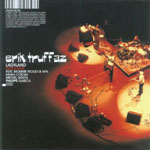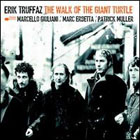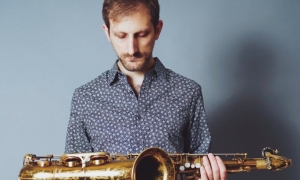Home » Jazz Articles » Interview » Erik Truffaz: Another Day Another Life
Erik Truffaz: Another Day Another Life
My way is really between pop and jazz. What interests me in jazz is just improvisation.
 Most musicians would be content with one successful band, but Swiss trumpeter Erik Truffaz is not the typical musician. Not content with leading two internationally acclaimed bands, he also finds time to collaborate with the likes of saxophonistsMichael Brecker and Joe Lovano, tablaist/producer Talvin Singh and trumpeter Jon Hassell. And if he's not playing a live soundtrack to a 1930s silent Japanese movie he can be found exploring the possibilities of electro-acoustic music with octogenarian Frenchman Pierre Henry or with electronic musicians from New York. His musical voyage of discovery takes him endlessly around the world and yet it could all have been so very different. But for a chance meeting it could have been another life.
Most musicians would be content with one successful band, but Swiss trumpeter Erik Truffaz is not the typical musician. Not content with leading two internationally acclaimed bands, he also finds time to collaborate with the likes of saxophonistsMichael Brecker and Joe Lovano, tablaist/producer Talvin Singh and trumpeter Jon Hassell. And if he's not playing a live soundtrack to a 1930s silent Japanese movie he can be found exploring the possibilities of electro-acoustic music with octogenarian Frenchman Pierre Henry or with electronic musicians from New York. His musical voyage of discovery takes him endlessly around the world and yet it could all have been so very different. But for a chance meeting it could have been another life. AAJ caught up with Erik Truffaz and his long-standing bassist Marcello Giuliani in Bangkok.
Erik Truffaz is in relaxed, joking mood before the sound-check at the Thailand Cultural Centre as he sorts out the lighting with the lighting lady. It takes all of five minutes. "I played here about ten years ago with a Thai project," Truffaz reminisces, "we spent about two hours for the lights. During the concert it was the exact opposite! I was not the leader so for me it was fantastic! The leader was an old man and he wanted exactly a white light on him when he came on stage and they did exactly the opposite! As he came on they put the white light on the other part of the stage!"
It was about ten years ago too that Erik Truffaz seemed to burst onto the international music scene, although his quartet had been gigging for six years already at that point. "We were very lucky, because before I was teaching piano and ten years later I met this man who had been my pupil and he told me, 'Oh, I'm working now in EMI records and if you have another project please give it to me and I'll try and give it to the manager of the jazz division.'" The rest, as they say, is history. Erik Truffaz's quartet became the first band Blue Note France signed. It was a lucky break as Truffaz is quick to recognize: "Incredible! Incredible because I was living on the border of Switzerland near Geneva and you cannot imagine releasing something if you don't live in Paris. So it was incredible because the man who signed us was not from Paris and didn't have this mentality. We were really lucky, because if we hadn't had this opportunity it would have been...another life."
 If Truffaz's parents had had their way it certainly would have been a different life. "My parents wanted me to be an electrician. I said no, it's not possible. I asked my father to buy a piano and I told him that in three years I was sure to be independent, making a living off music. In this period I had a dance band so he could feel that it was a possibility. They saw that I was not able to stay at school."
If Truffaz's parents had had their way it certainly would have been a different life. "My parents wanted me to be an electrician. I said no, it's not possible. I asked my father to buy a piano and I told him that in three years I was sure to be independent, making a living off music. In this period I had a dance band so he could feel that it was a possibility. They saw that I was not able to stay at school."
Whilst Truffaz may well have turned out to be an outstanding electrician, the recent release of his tenth album Face-a-Face (Blue Note, 2006) suggests that his decision to leave school early has been completely vindicated. His latest album, a double, features both his groups in concert. As Truffaz's music is aggrandized in concert it seems odd that it has taken ten years to release a live set. "The reason is that I've never recorded my live concerts well before," Truffaz explains. "When you record live you always think there is something you can do better." Bassist Marcello Giuliani adds: "Erik finally got a 16-track recorder and we recorded with that. Before that it was maybe more complicated to have a studio at the concerts all the time—it's expensive, and you don't want to tape just one concert. Imagine that one night you play bad. But it's true; we could have made it before."
In an era of rapidly improving technology the possibility of selling recordings of concerts via download a la Grateful Dead holds little attraction for either Truffaz or Giuliani. Giuliani explains: "Three guys buy it and one guy puts it on the net for free and that's it. And I think maybe there's a danger too, the more CDs you have of somebody the less value they have. Imagine if Pat Metheny released fourteen CDs a year—OK, you get one, you get two, great! And after? So when David Bowie said: 'It's great! I put all my music on the net.' You know, this guy's a millionaire. One thing you can't buy and that's 'live.'
"You can buy a DVD," Giuliani continues, "you have the sound but you are not in the concert. It's the only thing you can't duplicate." Truffaz adds, "and also the process of doing the CD was to have pictures, the booklet, and we released three thousand in a special edition with a free DVD of the two bands on tour." The CD as an object d'art? "Art object and industry object," Giuliani explains. "In the '60s and '70s you could live from the music. You could work your instrument all day and go and play at night and that's why in jazz or in funk and things like that you have such incredible bands. Guys like us, every musician we know now; they can live from the music because of that industry element. Sixty years ago, if you wanted to be a musician you could but you didn't live. Either you were a poor guy playing for four people in a house or you were a classical musician."
On stage, whether with the Erik Truffaz Quartet or with Ladyland, the music is a fusion of influences. Truffaz has always been open to new sounds and possibilities, going back to his days in Cruzeiro de Sul in 1983 with whom he made his first recordings. Truffaz says, "When you begin you work where you have opportunity. I love Brazilian music but it's not my music." His music is a hybrid it seems; jazz, pop, acid jazz, rap, drum'n'bass are all mixed up in the pot. "My music is really between pop and jazz. What interests me in jazz is just improvisation. Indian music interests me. It's improvisation."
A lot of these different elements came together when Truffaz and Giuliani joined the band Silent Majority in 1994 with the rapper Nya. "We played in this band for four years and after as the drum'n'bass was going on he [Giuliani] formed his own band. It was a drum'n'bass trio and with all this we had the idea to import this in the band."
Giuliani takes up the story: "The guy from Blue Note said, 'We have to do a little gift for Christmas for the guy who buys the CD Out Of A Dream (Blue Note 1997), so you do two songs in the studio and we'll put it with the CD as a gift.' So we had a jam with Nya with the quartet, we take Nya to a festival and we said, 'Why don't we try totally acoustic drum'n'bass?' And that's maybe where everything started you know. And the guy from Blue Note he listened to that and said: 'Wow! You have to do an album!' Six months after, from little jazz clubs we're doing five hundred people halls. And in France one year after we were quite big and doing gigs like La Cigale. It was this kind of mix, totally acoustic."
 And from France to the world. America however, seems reluctant to embrace Truffaz: "Yeah. It's a real challenge, but it costs too much. We did maybe three or four tours and it cost a lot—you have to pay the hotel." Giuliani adds: "And it doesn't sell that much. Drum'n'bass doesn't tour in America." Truffaz concurs, "New York is OK but to be honest in L.A. we had twenty people." Their music gets a much better reception elsewhere. "Eastern Europe is crazy! Russia! We did St. Petersburg six months ago—a little less than two thousand people and three hundred waiting outside. Russia, Poland, Romania, Bulgaria, Slovakia, the Czech Republic—it's full!"
And from France to the world. America however, seems reluctant to embrace Truffaz: "Yeah. It's a real challenge, but it costs too much. We did maybe three or four tours and it cost a lot—you have to pay the hotel." Giuliani adds: "And it doesn't sell that much. Drum'n'bass doesn't tour in America." Truffaz concurs, "New York is OK but to be honest in L.A. we had twenty people." Their music gets a much better reception elsewhere. "Eastern Europe is crazy! Russia! We did St. Petersburg six months ago—a little less than two thousand people and three hundred waiting outside. Russia, Poland, Romania, Bulgaria, Slovakia, the Czech Republic—it's full!"
It would be easy to become complacent, to continue recording and touring to a growing legion of fans, but Erik Truffaz is not the type to rest on his laurels. In recent years in particular he has collaborated on a number of diverse and stimulating projects. In 2003 he was commissioned to compose a soundtrack to a silent movie. He chose the 1932 silent movie Children Of Tokyo by the renowned Japanese film director Yasujiro Ozu. "The project was born," says Truffaz, "because there is a place in Paris called Site De La Musique, a big cultural place, one of the biggest in Paris for jazz and contemporary art. It was a concept—they were making a season of movies about kids. They proposed me to compose some music to a silent movie. I was really happy but afraid also. I chose The Kid by Charlie Chaplain but it didn't work. After I found the Ozu film and it spoke to me."
The project came about during the centenary anniversary of Ozu, a happy coincidence and Truffaz found himself invited to perform the film regularly around the world. For a musician driven by the desire to improvise this must have been a radical departure: "There is improvisation but really very little because everything is tight—you follow the images and you cannot let yourself totally go. After performing to this film we could give a very good concert because we had a lot of energy and we could really let ourselves go."
In July 2004 the Montreal Jazz Festival invited Truffaz to play in a special project based on the music of trumpeter Jon Hassell. For Truffaz it was an honor. "I love Jon Hassell," Truffaz enthuses. "I love his music. I love the man. He came with his music and we played, but there were three trumpet players—Paulo Fresu, Jon Hassell and myself. This man is a master and he was the first man who invented electro-jazz in the '70s. He released [Fourth World Vol. 1:] Possible Musics (EG, 1980) with Brian Eno. He's a master but he's not well known in the world—that's just because it happens like this."
The following year collaboration with fellow countryman Harald Haerter saw Truffaz rubbing shoulders with Michael Brecker, Joe Lovano and the late saxophonist Dewey Redman. Truffaz says of Haerter, "I've known him for four or five years. He is a really good guitarist." A short tour brought Truffaz onto the stage with Michael Brecker: "It was fantastic for me to perform with Michael Brecker. He's fantastic on stage. He's a good man. We had a very good complicity. He is a master. I heard on the radio recently Frank Zappa with Michael Brecker live and what playing! Just incredible!" The obvious admiration that Truffaz has for Brecker is mutual, as in interview Brecker has named Truffaz alongside his brother Randy Brecker and Roy Hargrove as his favorite trumpeters to play with. "With these type of men," Truffaz explains, "Joe Lovano or Michael Brecker, they are such monsters that they push you—it gives you power to be better for six months. It's inspiring."
 One of Truffaz's chief sources of inspiration is eighty year-old Frenchman Pierre Henry, one of the pioneers of electro-acoustic music. "When I met Pierre Henry," explains Truffaz, "it was because I asked him for a remix for my remix album—a completely crazy remix! So I met him and I said it would be good to play together because the trumpet works with his sound." Pierre Henry composed music especially for Truffaz which they performed live. "Pierre Henry is really an artist because he says, 'You know I can hear that people love my music and they stay in the venue so I'm not in a good way, because my way is to make people leave the venue. If it is convention it is not my way.' And this man is eighty years old! He really invented a style. He was one of the first—1952, you can't imagine! They didn't have samplers, just one track and he invented this kind of music. I try to take inspiration from this man. I'm more interested in this man than in hard bop and mainstream music because my way is really between pop and jazz."
One of Truffaz's chief sources of inspiration is eighty year-old Frenchman Pierre Henry, one of the pioneers of electro-acoustic music. "When I met Pierre Henry," explains Truffaz, "it was because I asked him for a remix for my remix album—a completely crazy remix! So I met him and I said it would be good to play together because the trumpet works with his sound." Pierre Henry composed music especially for Truffaz which they performed live. "Pierre Henry is really an artist because he says, 'You know I can hear that people love my music and they stay in the venue so I'm not in a good way, because my way is to make people leave the venue. If it is convention it is not my way.' And this man is eighty years old! He really invented a style. He was one of the first—1952, you can't imagine! They didn't have samplers, just one track and he invented this kind of music. I try to take inspiration from this man. I'm more interested in this man than in hard bop and mainstream music because my way is really between pop and jazz."
Inspired by artists ahead of their time such as Miles Davis, Pierre Henry, Jon Hassell and Yasujiro Ozu, Erik Truffaz is perhaps trying to create something new of his own, a music which transcends genre and categorization, something akin to what Jon Hassell calls "Fourth World" music. Truffaz is typically humble: "I don't think I'm a genius so I try to take inspiration from genius, but I am not. We try to do our best and we are happy when people are happy."
Selected Discography.
Our Theory, Yeah, That's Right (Nublu Records,2006)
Erik Truffaz, Face-a-Face (EMI Music, 2006)
Michel Benita, Drastic (BHM Records De, 2006)
Erik Truffaz, Saloua (EMI Music, 2005)
Harald Haerter, Catscan (Albeille, 2004)
Clones, Safety Copy (Sony Int'l, 2003)
Erik Truffaz, The Walk of the Giant Turtle (EMI Music, 2003)
Malia, Yellow Daffodils (Sony Int'l, 2002)
Erik Truffaz, Magrouni (EMI Music, 2002)
Francois Lindemann, Formats (TCB Music, 2001)
Erik Truffaz, Revisite (Blue Note, 2001)
Erik Truffaz, Mantis (Blue Note, 2001)
Goo, Elements (Shadow Records, 2001)
Erik Truffaz, Bending Corners (Blue Note, 1999)
Erik Truffaz, The Dawn (Blue Note, 1998)
Le Gooster, Zig Zag Zen (Shadow Records, 1997)
Erik Truffaz, Out Of A Dream (Blue Note, 1997)
Silent Majority, Curfew (UNIK, 1994)
Erik Truffaz, Nina Valeria (Elephant, 1993)
Maurice Magnoni, Etats des Sons : New York Suite (L&R Records, 1993)
Related Article
Erik Truffaz in Tampere (Concert Review, 2003)
Photo Credits
Top Photo: Jose Manuel Horna
Bottom Photo: Jos L. Knaepen
Tags
PREVIOUS / NEXT
Erik Truffaz Concerts
Support All About Jazz
 All About Jazz has been a pillar of jazz since 1995, championing it as an art form and, more importantly, supporting the musicians who make it. Our enduring commitment has made "AAJ" one of the most culturally important websites of its kind, read by hundreds of thousands of fans, musicians and industry figures every month.
All About Jazz has been a pillar of jazz since 1995, championing it as an art form and, more importantly, supporting the musicians who make it. Our enduring commitment has made "AAJ" one of the most culturally important websites of its kind, read by hundreds of thousands of fans, musicians and industry figures every month.





















